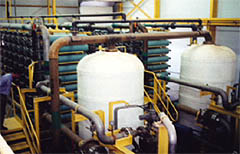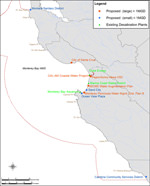Resource Issues: Desalination
 Introduction
Introduction
Desalination is the process by which salts and other chemicals are removed from salt or brackish water and other impaired water resources. It is also known as desalinization or desalting or commonly referred to as "desal."
In the past it has not been used extensively in this country, primarily because the cost of the product water has been so much higher than that from conventional sources. However, as traditional sources of fresh water continue to be depleted or degraded, central California coast water agencies and local jurisdictions are increasingly looking toward desalination as a drought-resistant water supply that could augment existing sources.
While desalination refers to any technology that removes salt from water, it includes a wide range of technologies that fall into two main categories, with many variations on each. Distillation processes involve heating the intake water to produce steam, which is then condensed to produce water with a very low salt concentration. Reverse Osmosis (RO) refers to the processes in which intake water is pressurized and forced through a semi-permeable membrane. The water passes through the membrane, but the salt molecules do not. With either technology, after the desalting process both fresh water and concentrated saline brine are produced. RO is the predominant technology being used and proposed in the sanctuary region.
 While only a few small-scale desalination facilities currently operate within the boundaries of the sanctuary, there has recently been an increase in interest for both private and public desalination plants, with several new facilities being pursued in the Monterey Bay and in Cambria.
While only a few small-scale desalination facilities currently operate within the boundaries of the sanctuary, there has recently been an increase in interest for both private and public desalination plants, with several new facilities being pursued in the Monterey Bay and in Cambria.
Beginning in 2001, throughout the process to update the MBNMS Management Plan, the sanctuary received considerable input from the public and regulatory agencies indicating that desalination is an emerging regional issue of concern that should be addressed as part of the updated plan. In response, the sanctuary convened a multi-stakeholder working group and developed a Desalination Action Plan, which lays out a framework for a regional approach to address desalination, aimed at reducing impacts to marine resources in the sanctuary through consideration of regional planning, facility siting issues, on-site mitigation measures, modeling and monitoring, and outreach and information exchange.
Sanctuary Regulations and Desalination
Without careful planning and mitigation measures, desalination plants have the potential to negatively impact the sensitive marine environment of the sanctuary. For example, marine organisms can be killed by impingement against seawater intake screens or by being pulled through the intake system (referred to as entrainment); marine life can be significantly impacted by discharge of the saline brine and other by-products produced by desalination, and; local seafloor habitat may be significantly altered by construction of intake and outfall structures.
Three of the sanctuary's regulations relate directly to desalination. The first involves a prohibition on discharging or depositing any material within Sanctuary boundaries. Since the brine effluent, and in some cases other materials, are usually disposed of in ocean waters, this activity requires Sanctuary authorization of Regional Water Quality Control Board (RWQCB) permits. The second sanctuary regulation pertains to discharging materials outside of the boundaries, which subsequently enter sanctuary waters and negatively impact MBNMS resources. As with the previous regulation, MBNMS approval via authorization of the RWQCB permit is required. The third relevant regulation involves a prohibition on activities that cause alteration of the seabed. Thus installation of certain desalination facility structures such as an intake/outfall pipeline on or beneath the ocean floor will also require sanctuary authorization.
NOAA Guidelines for Desalination Plants in the MBNMS
As part of the implementation of the MBNMS Desalination Action Plan, the sanctuary and NOAA's National Marine Fisheries Service released new guidelines to ensure that future desalination plants adjacent to the sanctuary are properly sited, designed, and operated to avoid damaging impacts to the marine environment.
In 2006, sanctuary staff partnered with the Association of Monterey Bay Area Governments (AMBAG) in comprehensively identifying the potential environmental, economic, and social impacts, both positive and negative, associated with seawater desalination if conducted in the Monterey Bay area. These MBNMS Desalination Guidelines were developed to specifically address the potential impacts that were identified during this initial investigation. The resulting report is theDesalination Feasibility Study for the Monterey Bay Region (2MB PDF).
The guidelines, released in May 2010, were developed in collaboration with the California Coastal Commission, the Central Coast Regional Water Quality Control Board, and other state and local agencies. While the sanctuary has some regulatory authority over all new desalination plants impacting its boundaries, these guidelines are non-regulatory, and were designed to address the collective mandates of numerous agencies involved in review of desalination proposals.
The new guidelines address issues associated with desalination including site selection, construction and operational impacts, plant discharges, and intake systems. The guidelines are intended to assist regulatory agencies in reviewing proposed desalination projects and to help ensure that project proponents and designers address resource protection concerns. For more information, download the Guidelines for Desalination Plants in the Monterey Bay National Marine Sanctuary (401KB PDF).
RESOURCES:
- NOAA Desalination Guidelines for Desalination in the MBNMS (401K PDF file)
- Association of Monterey Bay Area Governments
"Desalination Feasibility Study for the Monterey Bay Region" (Nov 2006) (2MB PDF file) - California Coastal Commission
"Seawater Desalination and the California Coastal Act" (Mar 2004) (364KB PDF file) - California Department of Water Resources
- National Water Research Institute
- Sanctuary Integrated Monitoring Network (SIMoN)
- State of California Water Desalination Task Force
"Findings and Reccomendations" Report (Oct 2003) (197KB PDF file) - The ABC's of Desalting (1.1MB PDF file)
- Pacific Institute Report
"Desalination, With a Grain of Salt—A California Perspective" (1.6MB PDF file)
